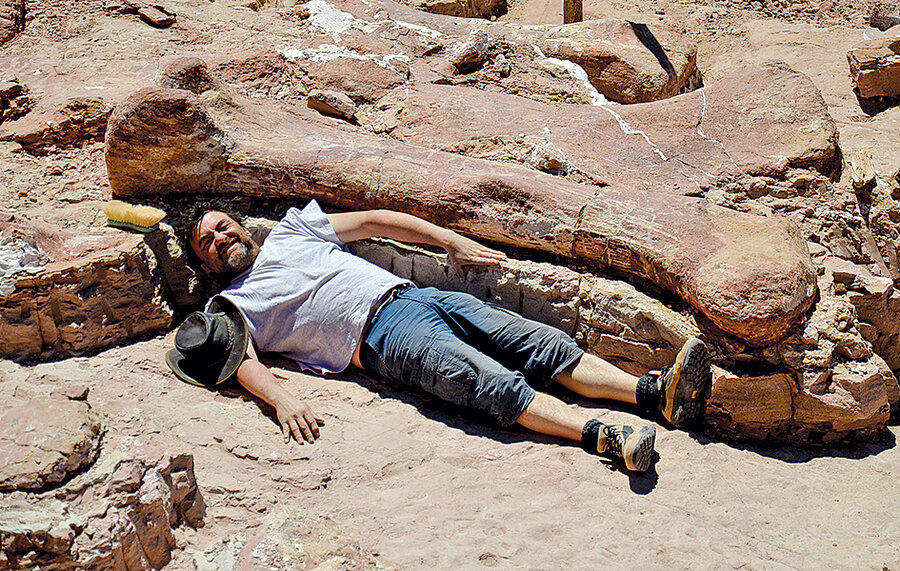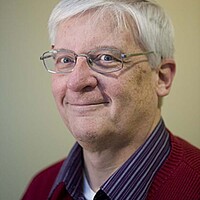Good Reads: From the biggest dino yet, to African oral histories, to the father of glam
Loading...
The new “Godzilla” movie just got upstaged by a real-life discovery in Argentina: the remains of what may be the biggest dinosaur yet. Based on its bones, the dinosaur (yet to be named) of the so-called Titanosaur species weighed 77 tons, as much as 14 African elephants. Estimates suggest the long-necked plant-eater measured some 65 feet tall and 130 feet long.
The discovery in the Patagonia region is remarkable, according to a story in The Independent, “because of the large number of bones and the high degree of preservation of their features.” Is this find the biggest dinosaur ever? Right now, “It’s like a fish story [by an angler], it really is,” says Dr. Jack Horner, a Montana State University paleontologist who was the inspiration for the character in the “Jurassic Park” films played by Sam Neill. “The science will come after, when they start studying the thing.”
Jobs return to the US, for robots
Good news: Fewer jobs will be going overseas chasing lower-wage workers. But the bad news is that robots, not humans, will be doing those jobs. Need examples? Foxconn, the controversial maker of iPhones that employs low-wage workers in China, will be opening a new $40 million plant in Pennsylvania that uses advanced robotics, says Colin Lewis in a blog post at Harvard Business Review. Tesla Motors, a US-based builder of state-of-the-art electric cars, won’t head overseas because its advanced robotic manufacturing techniques are cheaper.
One outsourcing company tells its clients it can cut their costs as much as 70 percent if they stay in the United States and use the latest automation software. “For managers, the trend toward botsourcing will require a shift in thinking,” Mr. Lewis writes. “Rather than moving operations to wherever work costs the least, consider which pieces can be automated, and how best to combine human and robotic expertise.”
The man with 10,000 tales
When Harold Scheub went to Africa in 1967 he didn’t bring a rifle to hunt big game. Instead, he spent years trekking 6,000 miles up and down the continent armed only with a bulky tape recorder to bag something else: nearly 10,000 oral histories. Today the octogenarian professor is still translating (from languages like Xhosa, Swahili, and Yoruba) and transcribing his interviews, writes Tim McDonnell for the online magazine Narrative.ly.
The stories he found in Africa are colorful and often complex, but they also share traits with other cultures. “Stories in all societies deal with change, transformation that takes place in human lives,” Professor Scheub tells Mr. McDonnell. “Because these are scary parts of our lives. We’re moving from childhood to adulthood, from being unmarried to being married, from the pre-midlife crisis to the post-midlife crisis, all kinds of things. And so stories place a lot of emphasis on transformation....”
Hollywood’s beauty factor
He lightened Rudolph Valentino’s skin tone, transforming him from an early movie villain to one of its first matinee idols. When movie studios switched from harsh carbon arc lights to softer incandescents, he seized the opportunity and created the dazzling blond cinema siren, even flecking gold dust in Marlene Dietrich’s coif. He invented the eyebrow pencil and lip gloss, as well as camera-ready sweat, tears, and blood – even a pie topping that stuck to the face better than real cream. He devised a lip liner that allowed actresses such as Joan Crawford to change the shape of their lips.
Max Factor was a Jewish immigrant from Poland (his name shrank from Faktorowicz at Ellis Island) who changed not only the movie industry but also America’s concept of beauty, concludes Sasha Archibald in the online magazine Cabinet. Because of Factor, “makeup” (a word coined by Factor) became part of common culture, no longer confined to use by actors or women of questionable character. “With its playful ring,” writes the author, Factor’s “Pan-Cake Make-Up offered a bit of make-believe to everyday life.”
Billionaires with sci-fi imaginations
Science fiction appeals to today’s billionaires who yearn to do big things. Early on Jeff Bezos wanted to use “MakeitSo.com” as Amazon’s URL in homage to Captain Picard of “Star Trek: The Next Generation.” PayPal cofounder Elon Musk envisions a hyperloop high-speed train that travels faster than a plane. Google chief executive officer Larry Page has set his sights on a truly big goal: eliminating illness – and even death. “These ambitious, mogul-driven projects all mimic one of science fiction’s raisons d’être: the deeply satisfying literary exercise of world-building...,” writes Gene Seymour in a fascinating essay in The Baffler, a printed and digital magazine of art and criticism.
Over the centuries science fiction has had the “capacity to clear the mental palette, to squeegee away the mundane distractions of what’s redundantly termed ‘present-day reality,’ ” Mr. Seymour writes. While some see an inherently libertarian viewpoint in science fiction, in which government is the enemy (but what about the noble Federation of “Star Trek”?), the author is not persuaded. Science fiction’s “first, best promise – being alive to possibility – is too vital and too bright to be hammered, bent, or squeezed into anyone’s ideology. If that makes me a libertarian – well, I still have a problem with that.”








